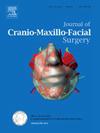Crouzon和Apert综合征对上呼吸道形态的不同影响:阻塞性睡眠呼吸暂停的意义。
IF 2.1
2区 医学
Q2 DENTISTRY, ORAL SURGERY & MEDICINE
引用次数: 0
摘要
患有综合征性颅缝紧闭的儿童面临阻塞性睡眠呼吸暂停(OSA)的高风险,但其潜在机制尚不清楚。本研究探讨了在控制年龄和姿势的情况下,Crouzon和Apert综合征如何影响气道形态并导致OSA。我们还检查了上呼吸道和颅面区域(骨骼和软组织)之间的共变。我们分析了37例综合征性颅缝闭锁患者和53例对照儿童,年龄从0到49个月。在上气道的3D模型上放置一组52个地标,并在可用时收集呼吸暂停-低通气指数(AHI)。我们的几何形态分析表明,年龄、口腔张开度和颅颈姿势显著影响气道形状,强调了标准化成像的必要性。在控制了这些因素后,我们强调了Crouzon综合征患者口咽部的变化,而Apert综合征则改变了鼻咽部。没有发现气道形状与OSA之间的直接联系。上呼吸道生长及其与颅面区域的形态共变不受综合征性颅缝闭锁诊断的影响。最后,这些发现强调了综合征特异性气道差异,FGFR突变影响骨骼和周围软组织。这项研究为更精确的呼吸道诊断和个性化治疗方案提供了有价值的见解。本文章由计算机程序翻译,如有差异,请以英文原文为准。
Differential impact of Crouzon and Apert syndromes on upper airways morphology: implications for Obstructive Sleep Apnoea
Children with syndromic craniosynostoses face high risk of obstructive sleep apnoea (OSA), but the underlying mechanisms remain unclear. This study investigated how Crouzon and Apert syndromes affect airway morphology and contribute to OSA, controlling for age and posture. We also examined the covariation between the upper airways and the craniofacial region (skeleton and soft tissues). We analysed 37 patients with syndromic craniosynostoses, and 53 control children aged from 0 to 49 months old. A set of 52 landmarks was placed on the 3D models of the upper airways and collected, when available, the apnoea-hypopnoea index (AHI). Our geometric morphometric analyses demonstrated that age, mouth openness and craniocervical posture significantly influenced airway shape, emphasizing the need for standardised imaging. After controlling these factors, we highlighted oropharynx changes in patients with Crouzon syndrome, while Apert syndrome altered the nasopharynx. No direct link between airway shape and OSA was found. Upper airways growth and its morphological covariation with the craniofacial region were not impacted by the diagnosis of syndromic craniosynostosis. Finally, these findings highlight syndrome-specific airway differences, FGFR mutations impacting both bone and surrounding soft tissues. This study provides valuable insights for more precise respiratory diagnoses and personalised treatment plans.
求助全文
通过发布文献求助,成功后即可免费获取论文全文。
去求助
来源期刊
CiteScore
5.20
自引率
22.60%
发文量
117
审稿时长
70 days
期刊介绍:
The Journal of Cranio-Maxillofacial Surgery publishes articles covering all aspects of surgery of the head, face and jaw. Specific topics covered recently have included:
• Distraction osteogenesis
• Synthetic bone substitutes
• Fibroblast growth factors
• Fetal wound healing
• Skull base surgery
• Computer-assisted surgery
• Vascularized bone grafts

 求助内容:
求助内容: 应助结果提醒方式:
应助结果提醒方式:


